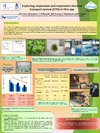Please use this identifier to cite or link to this item:
https://accedacris.ulpgc.es/jspui/handle/10553/11841
| Title: | Exploring respiration and respiratory electron transport system (ETS) in Ulva spp. | Authors: | Viera-Rodríguez, M.A. Packard, Theodore T Asensio Elvira, María Teresa Maldonado-Uribe, Federico Gómez, May |
UNESCO Clasification: | 241707 Algología (ficología) 241719 Fisiología vegetal |
Keywords: | Electrom Transport System Ulva spp. Respiratory metabolism |
Issue Date: | 2014 | Abstract: | Respiration is a key ecological index. For either individuals or communities, it can be use to assess carbon and energy, demand and expenditure as well as carbon flow rates through food webs. When combined with productivity measurements it can establish the level of metabolic balance. When combined with measurements of respiratory capacity, it can indicate physiological state. Here, we report pilot studies the metabolism of the green algae, Ulva rotundata that inhabits intertidal pools of Gran Canaria. As a starting point we used the electron transport system (ETS) to differentiate between different growing conditions in the natural environment. We suspected different levels of stress associated with these conditions and looked for the influence of this stress in the ETS measurements. This technique has been successfully applied to study bacteria, phytoplankton and zooplankton in the ocean, but it has not been used to study sessile marine macroalgae. These neritic and littoral macrophytes have major ecological and industrial importance, yet little is known about their respiratory physiology. Such knowledge would strengthen our understanding of the resources of the coastal ocean and facilitate its development and best use. Here, we modified the ETS methodology for Ulva rotundata. With this modified ETS assay we investigated the capacity of Ulva to resist anoxia. We measured respiration with optodes (Fibox 4, Presens) in the dark to the point of oxygen exhaustion and through 24 h of anoxia. Then we exposed the Ulva to light and followed the oxygen increase due to photosynthesis. We discuss here the capacity of Ulva to survive during anoxia. | URI: | https://accedacris.ulpgc.es/handle/10553/11841 | Source: | IV Simposio de Ciencias del Mar |
| Appears in Collections: | Póster de congreso |
This item is licensed under a Creative Commons License

